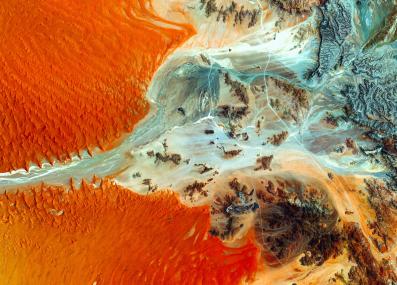Have a question?
How do we know what the Earth’s climate was like millions of years ago?
In seafloor sediments, stalagmites, ice sheets, and other natural records preserved from the ancient past, “paleoclimatologists” search for clues to past temperatures, atmospheres and weather patterns.
March 21, 2025
For 10,000 years leading up to the 20th century, our climate was remarkably stable. The Earth’s average temperature never changed by more than about 1° C, and only in slow, steady shifts over thousands of years.1,2,3 All human history as we would recognize it, with farms and cities and complex societies, falls in this era of stability.
But in the larger view, the Earth’s climate is anything but steady. “Earth's climate has always been changing,” says David McGee, professor of Earth and planetary sciences at MIT. “Even in the last 1% of Earth’s history, so the last 45 million years, we've seen changes in the Earth's mean temperature of roughly 30 to 40 degrees Fahrenheit [17 to 22° C].”
Of course, we don’t have 45 million years of thermometer records to tell us this. Instead, scientists search for clues about ancient climates in the oldest surviving features of the natural world: a field of science called “paleoclimate.”
“Paleoclimate is the art of the possible,” says McGee. “There are only so many things that are left over from thousands of years ago, and even fewer left over from millions of years ago. We have to rely upon natural archives, things that grow or are deposited and somehow record information about the climate around them as they form.”
A good example is the layers of sediment that build up on the ocean floor. “If you're able to drill or core down into them, you essentially have a time machine,” McGee explains. “You're able to look at older and older layers as you go down.”
Within those layers are—to name one example—the fossilized remains of foraminifera, plankton that have been around for hundreds of millions of years. “They happen to form small calcium carbonate shells,” says McGee. “And the composition of those shells is very strongly related to temperature. As the temperature gets hotter, the foraminifera become more sloppy chemists, and they allow more magnesium into their calcium carbonate shell.” If the foraminifera in a layer of sediment are rich in magnesium, that’s a sign that the world was warmer when that layer was formed.
Anything that contains oxygen can also be a good temperature record—including the calcium carbonate in ancient shells and bones, and the water molecules in layers of ice in Antarctica and Greenland. Not all oxygen in the atmosphere is alike: there are heavier and lighter “isotopes,” and they behave a little differently. Water containing the lighter 16O, for instance, evaporates faster. As a result, the abundance of 16O changes with temperature in predictable ways.
Paleoclimatologists also check ice and ocean sediments, and other records like stalagmites and tree rings, against each other to make sure they give consistent answers. “We combine evidence from all of these to get a full view of what Earth's temperature was in the past,” says McGee.
Temperature is not the only thing paleoclimatologists investigate. Some records teach us about ancient rainfall patterns, or gases in the atmosphere. Carbon dioxide (CO2) is especially important: this is the main greenhouse gas driving today’s warming, so we can learn a lot about our changing climate from its history.
For the relatively recent past, scientists measure CO2 in real samples of ancient air, trapped in tiny bubbles in Antarctic ice. Those records go back about a million years. For earlier eras, ocean sediments come in handy again. As the amount of CO2 in the air rises and falls, the chemistry of seawater changes, and those changes can be reconstructed from what falls to the seafloor.
What have we learned from these records? For one, we can confirm the basic truth of climate change: whenever CO2 rises, temperatures will rise too, a pattern that has held for the past 100 million years.
But we can also get a preview of a warmer future. By the end of this century, if we don’t address our runaway CO2 emissions, we may see another two or three degrees Celsius of warming. There have been several past periods when the Earth’s temperature fell in this range. “And they look really, really different from today,” McGee says. “Sea levels were 30 or 40 feet higher, vegetation patterns were quite different, rainfall patterns were quite different. So they give us a sense that a few degrees is a big deal.”
Through a paleoclimatologist’s eyes, the Earth may look something like a sleeping giant: mostly predictable, but capable of sudden violence if it’s disturbed.
“I think what paleoclimate teaches us is that the Earth system is remarkably resilient,” says McGee. “It has been kicked around in a whole lot of ways throughout history. If it gets a big input of CO2, it does take that carbon and put it back into sediments, gradually, over about a million years, and come back somewhere close to where it started.”
But the adjustment period can be a harsh one. At the end of the last ice age, 17,000 years ago, the Earth warmed about 5.5° C over 7,000 years—about ten times slower than climate change today, but fast by the standards of the past. “And in that time period, we see the biggest rainfall changes that the world has seen in the last 100,000 years. The biggest droughts in West Africa, the biggest collapses of the Asian monsoon, the wettest times in South America, the wettest times in the American West. And all of this was happening not during the peak of the last ice age, when the temperature was the most different, but during this warming afterwards, when the world was adjusting to changing temperatures.”
“And so I think the Earth is going to be fine, in a few million years, regardless of what we do,” McGee adds. “It's really human society and the species we care about that are going to experience this disruption in the short term. And so the more we can limit the range of future warming, I think the more pain we protect ourselves from.”
Submit your own question to Ask MIT Climate
Get the latest from Ask MIT Climate monthly in your inbox
1 Osman, Matthew, et al. "Globally resolved surface temperatures since the Last Glacial Maximum." Nature 599 (2021). https://doi.org/10.1038/s41586-021-03984-4.
2 Kaufman, Darrell, et al. "Holocene global mean surface temperature, a multi-method reconstruction approach." Scientific Data 7 (2020). https://doi.org/10.1038/s41597-020-0530-7.
3 Marcott, Shaun, et al. "A reconstruction of regional and global temperature for the past 11,300 years." Science 339 (2013). https://doi.org/10.1126/science.1228026.








